Long-Term In-Service Monitoring and Performance Assessment of the Main Cables of Long-Span Suspension Bridges
Abstract
:1. Introduction
2. Bridge Description and Instrumentation
2.1. The Nanxi Suspension Bridge (NSB)
2.2. Monitoring System of Cable Strands’ Tension Force
2.3. Estimation of Main Cable’s Tension Force
3. Evaluation Methods
3.1. Uniformity of Cable Strands’ Tension Forces
3.2. Thresholds of Main Cable’s Safety Factor
4. Analysis of Monitoring Data
4.1. One-Day Monitoring Data
4.2. Long-Term Monitoring Data
5. Conclusions
Acknowledgments
Author Contributions
Conflicts of Interest
References
- Chang, P.C.; Flatau, A.; Liu, S.C. Review paper: Health monitoring of civil infrastructure. Struct. Health Monit. 2003, 2, 257–267. [Google Scholar] [CrossRef]
- Ou, J.; Li, H. Structural Health Monitoring in mainland China: Review and Future Trends. Struct. Health Monit. 2010, 9, 219–231. [Google Scholar]
- Webb, G.T.; Vardanega, P.J.; Middleton, C.R. Categories of SHM deployments: Technologies and Capabilities. J. Bridge Eng. 2015, 20, 04014118. [Google Scholar] [CrossRef]
- Deng, Y.; Liu, Y.; Feng, D.M.; Li, A.Q. Investigation of fatigue performance of welded details in long-span steel bridges using long-term monitoring strain data. Struct. Control Health Monit. 2015, 22, 1343–1358. [Google Scholar] [CrossRef]
- Deeble Sloane, M.J.; Betti, R.; Marconi, G.; Hong, A.; Khazem, D. Experimental analysis of a nondestructive corrosion monitoring system for main cables of suspension bridges. J. Bridge Eng. 2013, 18, 653–662. [Google Scholar] [CrossRef]
- Wang, J.; Liu, W.; Wang, L.; Han, X. Estimation of main cable tension force of suspension bridges based on ambient vibration frequency measurements. Struct. Eng. Mech. 2015, 56, 939–957. [Google Scholar] [CrossRef]
- Ansari, F. Sensing Issues in Civil Structural Health Monitoring; Springer: Dordrecht, The Netherlands, 2003. [Google Scholar]
- Zhao, Y.; Wang, M.L. Fast EM stress sensors for large steel cables. In Proceedings of the SPIE 6934, Nondestructive Characterization for Composite Materials, Aerospace Engineering, Civil Infrastructure, and Homeland Security, San Diego, CA, USA, 9 March 2008. [Google Scholar]
- Liu, L.; Chen, W.; Zhang, P.; Hu, S. Theoretical model and optimization of magnetic stress sensor for measuring steel cable stress. In Proceedings of the 6th International Symposium on Precision Engineering Measurements and Instrumentation, Hangzhou, China, 28 December 2010. [Google Scholar]
- Zhang, X.; Shen, R.; Tang, M.; Ye, H. Accurate calculation and adjustment methods for cable forces of anchor-span strands for suspension bridges. J. Southwest Jiaotong Univ. 2012, 47, 551–557. [Google Scholar]
- Wang, D.; Zhang, W.; Liu, Y.M.; Liu, Y. Strand tension control in anchor span for suspension bridge using dynamic balance theory. Lat. Am. J. Solids Struct. 2016, 13, 1838–1850. [Google Scholar] [CrossRef]
- Yu, Y.; Zhang, C.; Zhu, X.; Kang, W.H.; Mao, X.; Uy, B. Vibration based wireless measurement system for bridge cable tension monitoring. Adv. Struct. Eng. 2014, 17, 1657–1668. [Google Scholar] [CrossRef]
- Feng, D.; Feng, M.Q. Experimental validation of cost-effective vision-based structural health monitoring. Mech. Syst. Signal Proc. 2017, 88, 199–211. [Google Scholar] [CrossRef]
- Feng, D.; Scarangello, T.; Feng, M.Q.; Ye, Q. Cable tension force estimates using cost-effective noncontact vision sensor. Measurement 2017, 99, 44–52. [Google Scholar] [CrossRef]
- Nan, Q. Application of FBG force testing ring in monitoring cable force of suspension bridge. J. Highw. Transp. Res. Dev. 2010, 27, 64–68. [Google Scholar]
- Li, D.; Zhou, Z.; Ou, J. Development and sensing properties study of FRP-FBG smart stay cable for bridge health monitoring applications. Measurement 2011, 44, 722–729. [Google Scholar] [CrossRef]
- Kim, Y.S.; Sung, H.J.; Kim, H.W.; Kim, J.M. Monitoring of tension force and load transfer of ground anchor by using optical FBG sensors embedded tendon. Smart Struct. Syst. 2011, 7, 303–317. [Google Scholar] [CrossRef]
- Lanza di Scalea, F.; Rizzo, P.; Seible, F. Stress measurement and defect detection in steel strands by guided stress waves. J. Mater. Civ. Eng. 2003, 15, 219–227. [Google Scholar] [CrossRef]
- Nucera, C.; Lanza di Scalea, F. Monitoring load levels in multi-wire strands by nonlinear ultrasonic waves. Struct. Health Monit. 2011, 10, 617–629. [Google Scholar] [CrossRef]
- Deng, Y.; Liu, Y.; Feng, D.M. Monitoring damage evolution of steel strand using acoustic emission technique and rate process theory. J. Cent. South Univ. 2014, 21, 3692–3697. [Google Scholar] [CrossRef]
- Blachowski, B.; Swiercz, A.; Gutkiewicz, P.; Szelazek, J.; Gutkowski, W. Structural damage detectability using modal and ultrasonic approaches. Measurement 2016, 85, 210–221. [Google Scholar] [CrossRef]
- Pnevmatikos, N.G.; Blachowski, B.; Hatzigeorgiou, G.D.; Swiercz, A. Wavelet analysis based damage localization in steel frames with bolted connections. Smart Struct. Syst. 2016, 18, 1189–1202. [Google Scholar] [CrossRef]
- Han, W.; Cleghorn, W.L. Vibration analysis of pre-stressed pressure sensors using finite element method. Finite Elem. Anal. Des. 1998, 30, 205–217. [Google Scholar] [CrossRef]
- Zhou, Y.H. An analysis of pressure-frequency characteristic of vibrating string-type pressure sensors. Int. J. Solids Struct. 2001, 38, 7101–7111. [Google Scholar] [CrossRef]
- Huang, P.M.; Mu, Y.K. Tension control system of suspension bridge anchor cable. J. Chang’an Univ. (Nat. Sci. Ed.) 2007, 27, 42–45. [Google Scholar]
- Choi, S. W.; Kwon, E.M.; Kim, Y.; Hong, K.; Park, H.S. A practical data recovery technique for long-term strain monitoring of mega columns during construction. Sensors 2013, 13, 17346–17361. [Google Scholar] [CrossRef] [PubMed]
- Myers, J.; Bloch, K. Comparison of prestress losses for pedestrian bridges constructed with high-strength concrete and high-strength self-consolidating concrete. J. Bridge Eng. 2013, 18, 871–878. [Google Scholar] [CrossRef]
- Liu, Y.; Deng, Y.; Cai, C.S. Deflection monitoring and assessment for a suspension bridge using a connected pipe system: A case study in China. Struct. Control Health Monit. 2015, 22, 1408–1425. [Google Scholar] [CrossRef]
- Ministry of Transport of the People’s Republic of China. Specification for Design Highway Suspension Bridge JTG TD65-05-2015; China Communications Press: Beijing, China, 2015. [Google Scholar]
- Haight, R.; Billington, D.; Khazem, D. Cable safety factors for four suspension bridge. J. Bridge Eng. 1997, 2, 157–167. [Google Scholar] [CrossRef]
- Ministry of Transport of the People’s Republic of China. General Code for Design Highway Bridges and Culverts JTG D60-2004; China Communications Press: Beijing, China, 2004. [Google Scholar]
- Gimsing, N.J.; Georgakis, C.T. Cable Supported Bridges, Concept & Design, 3rd ed.; John Wiley & Sons: New York, NY, USA, 2012. [Google Scholar]
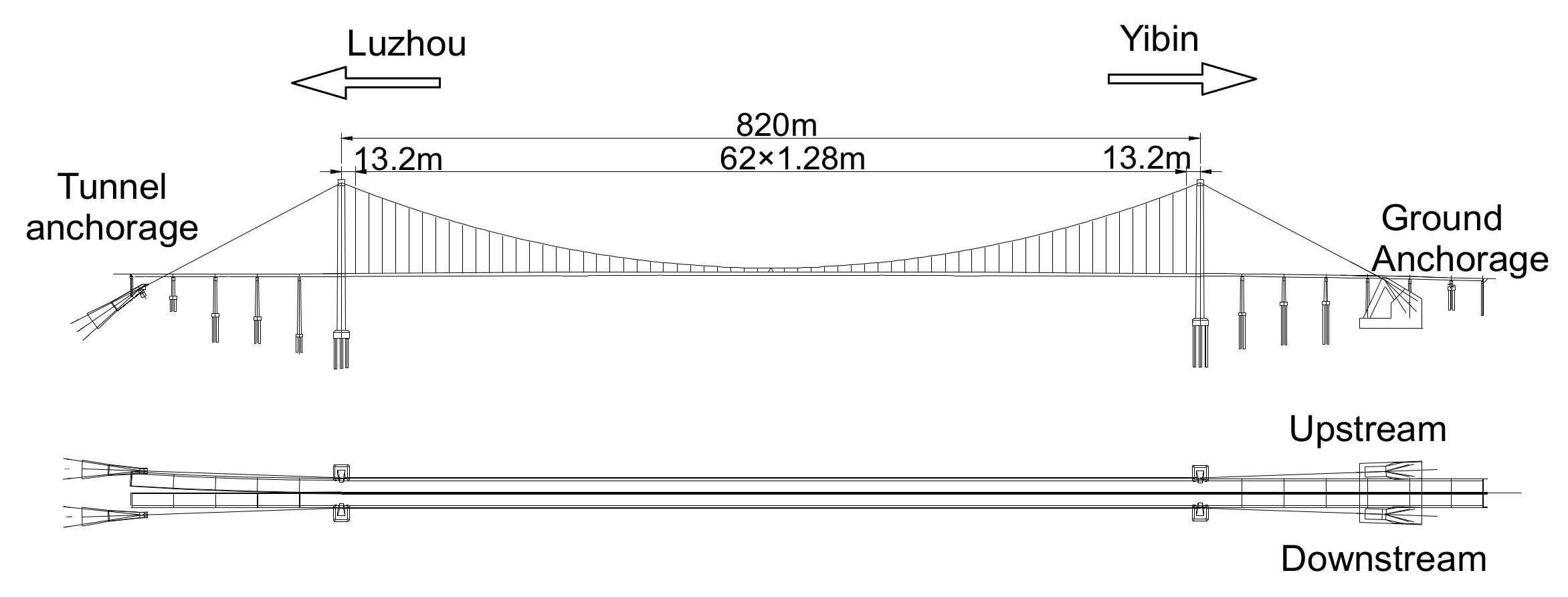
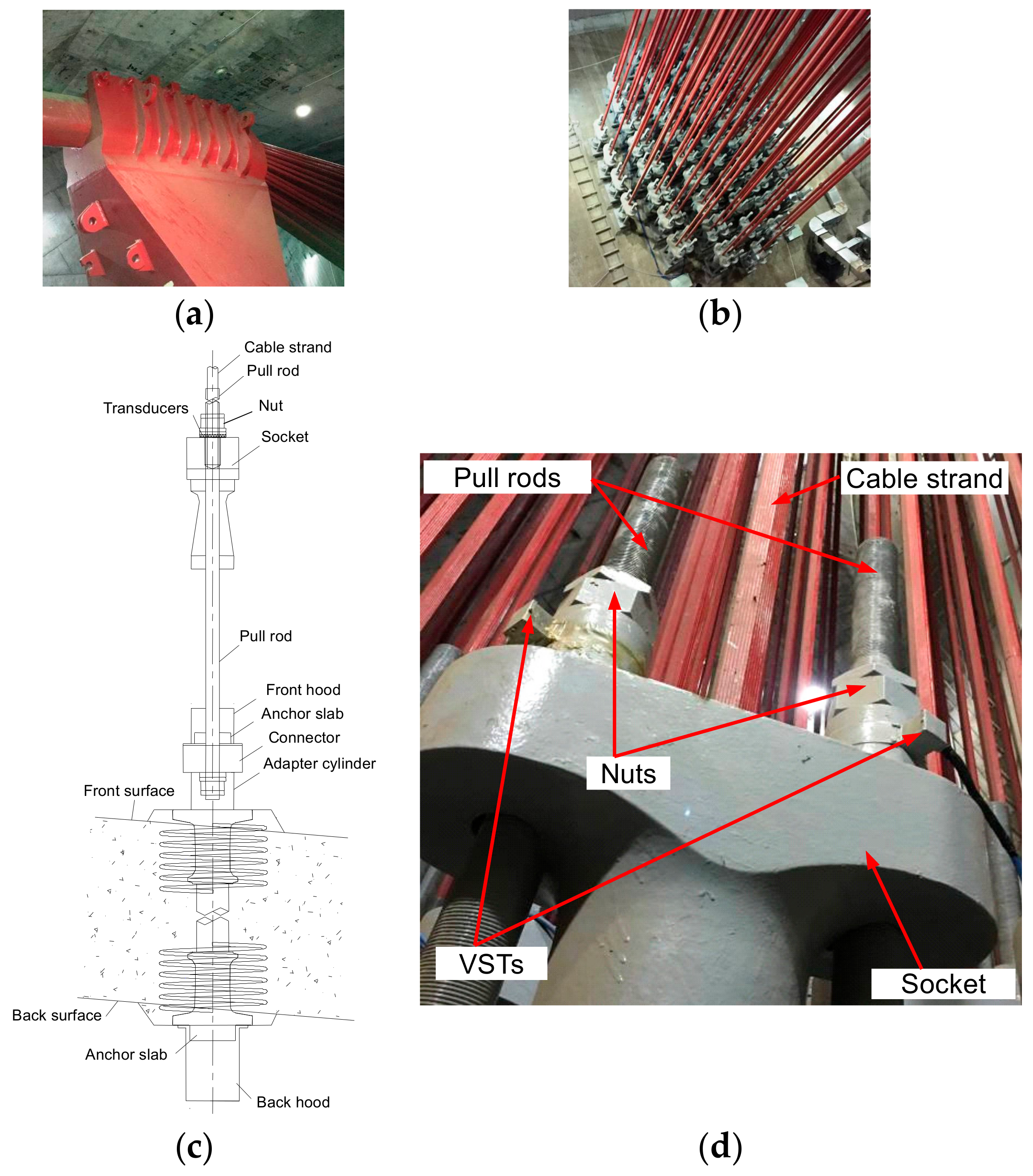
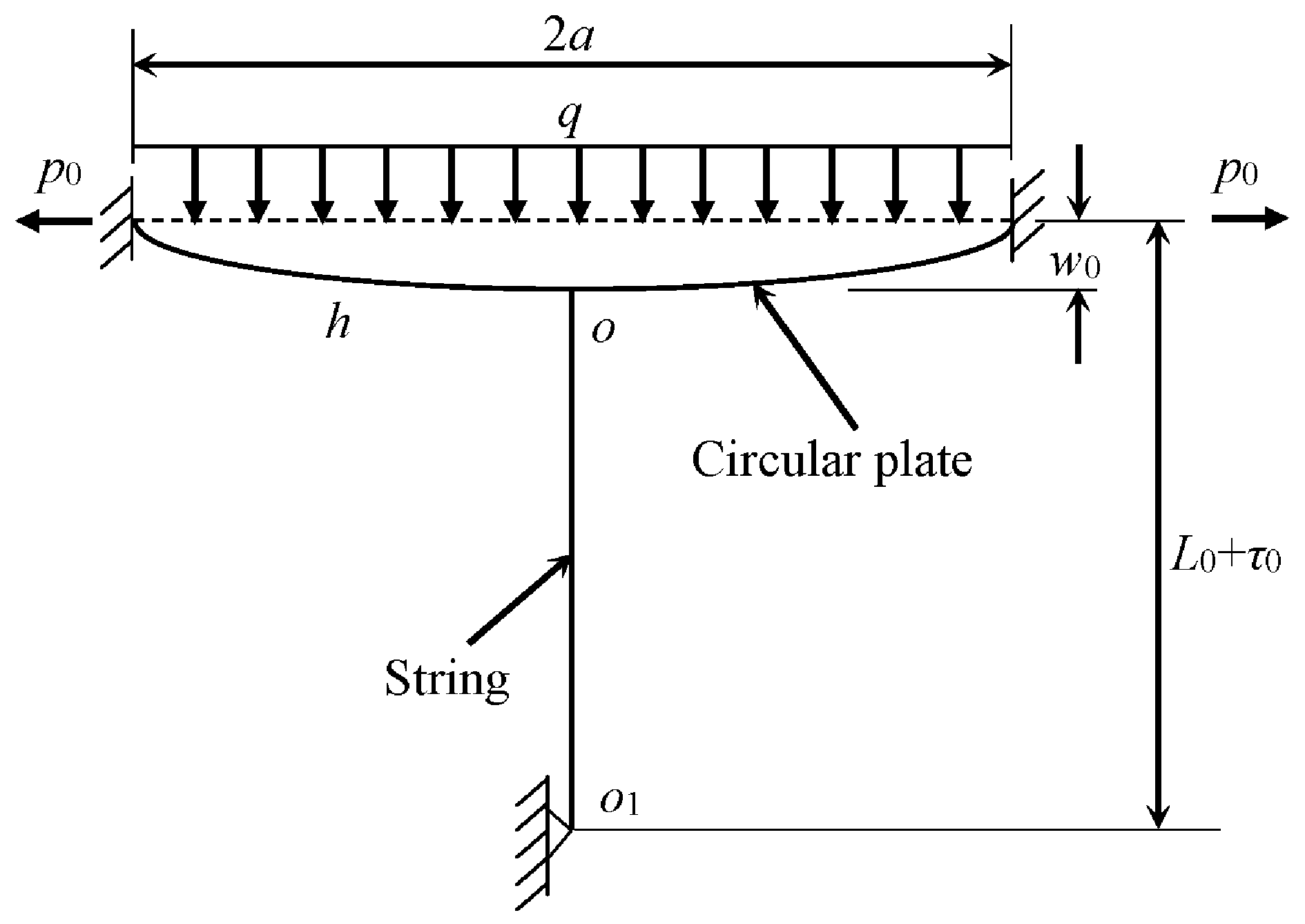
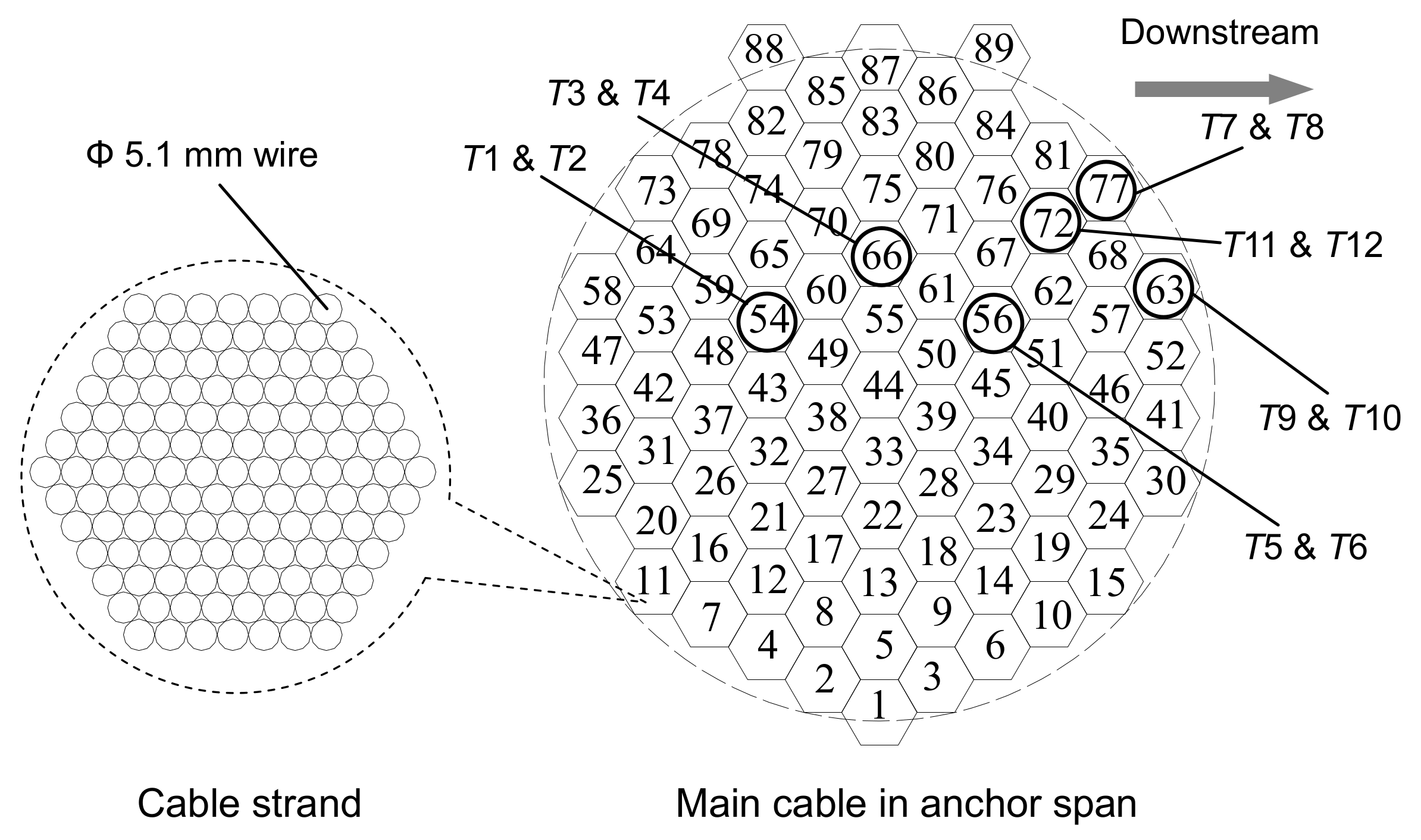
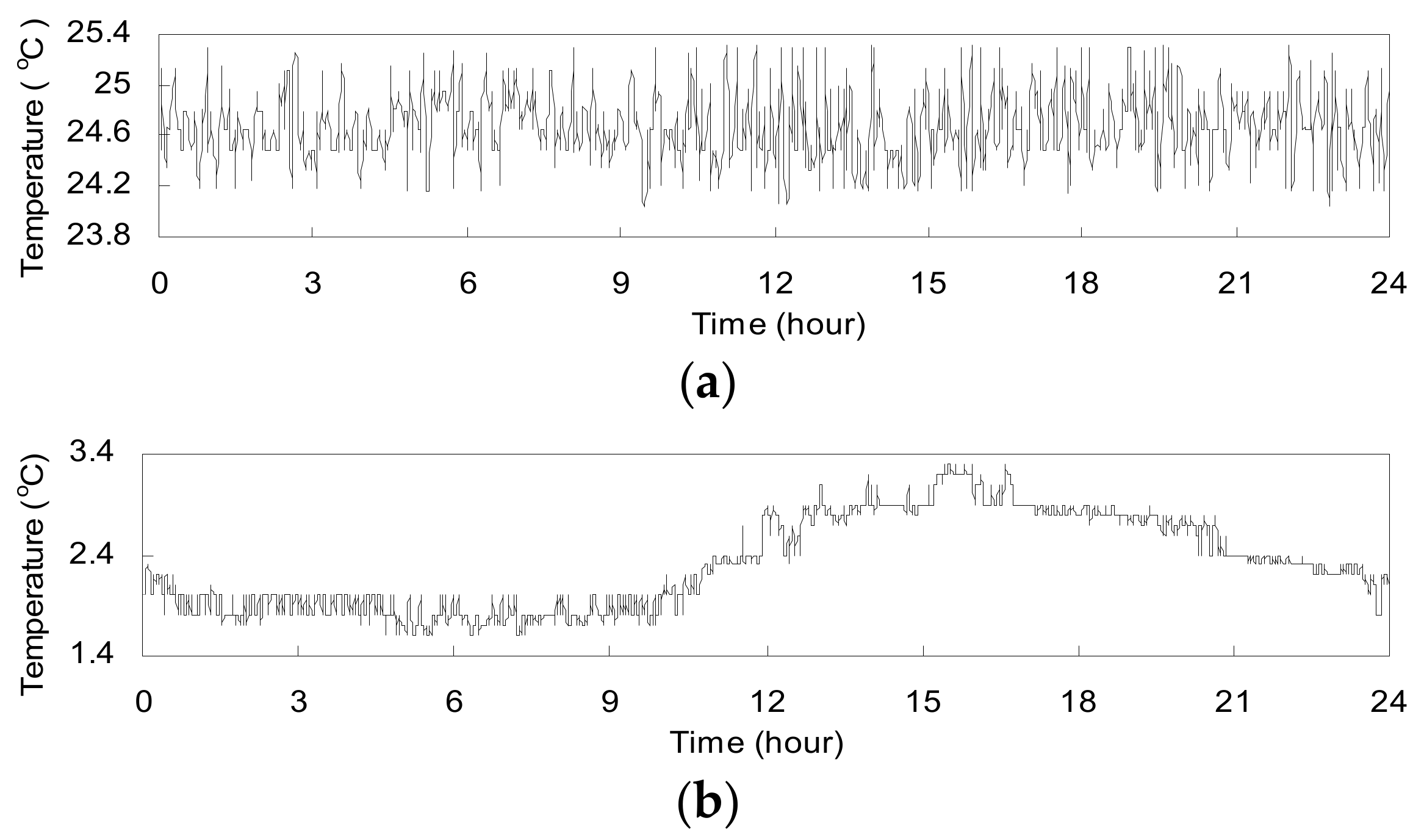
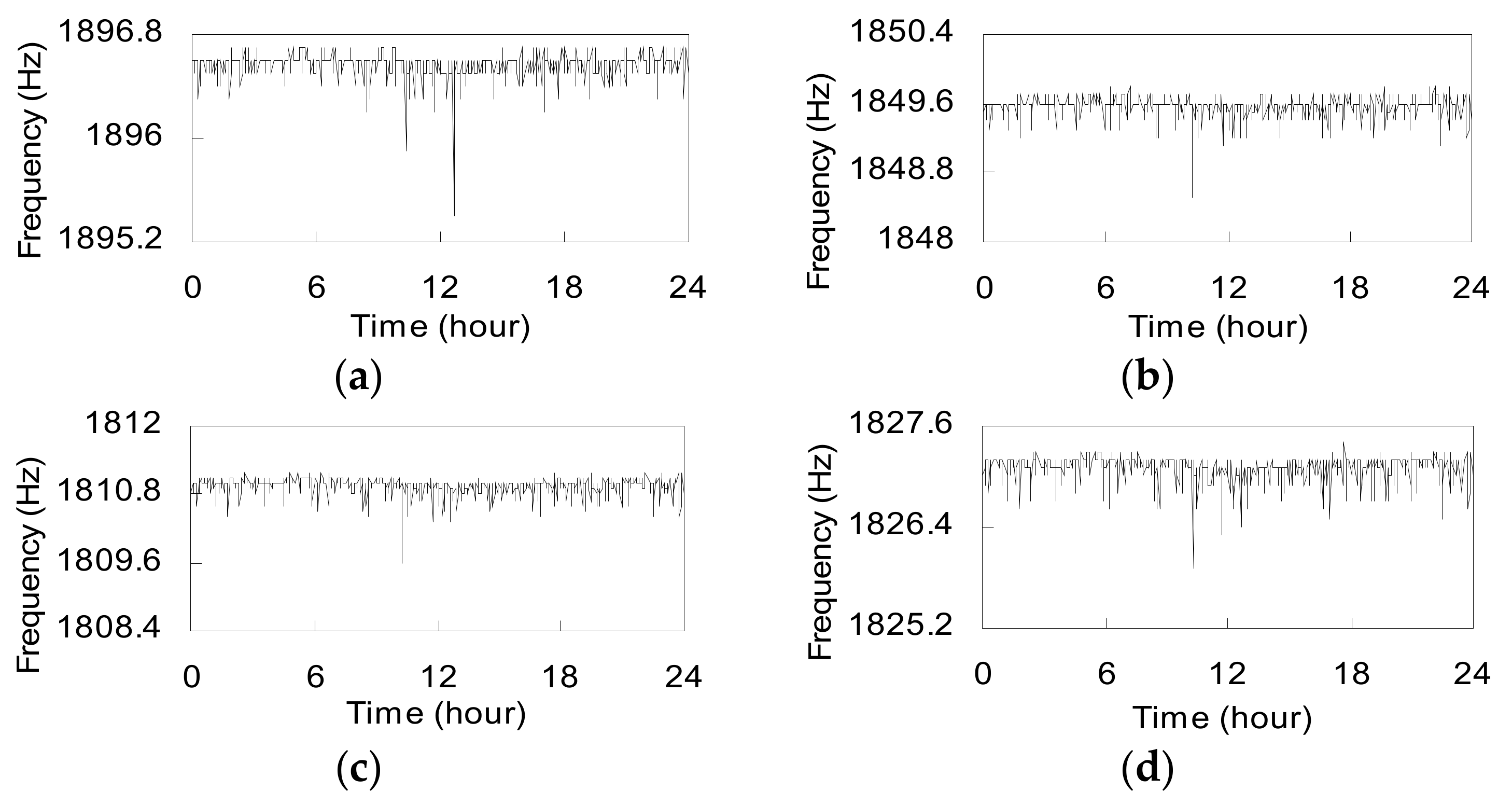
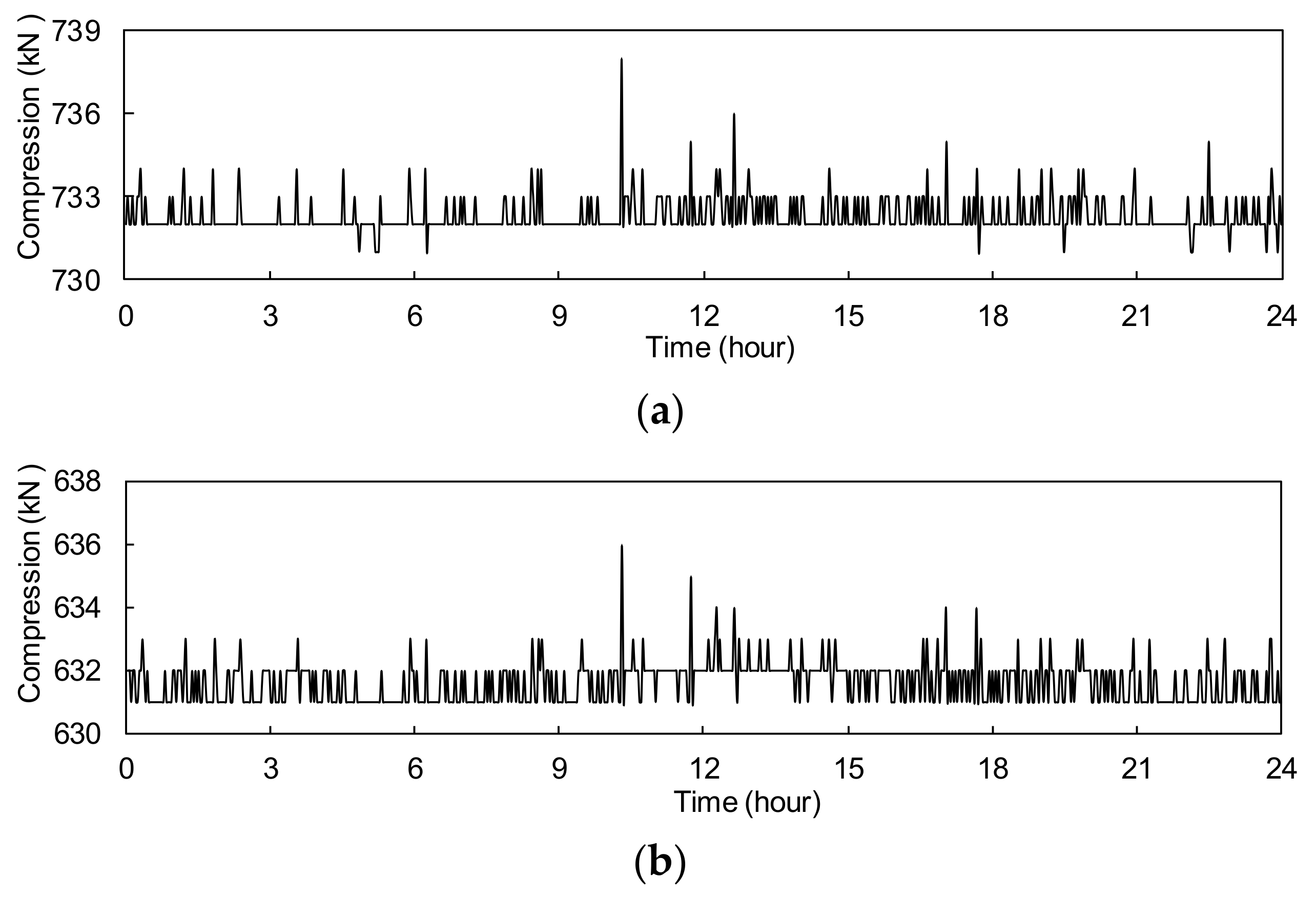
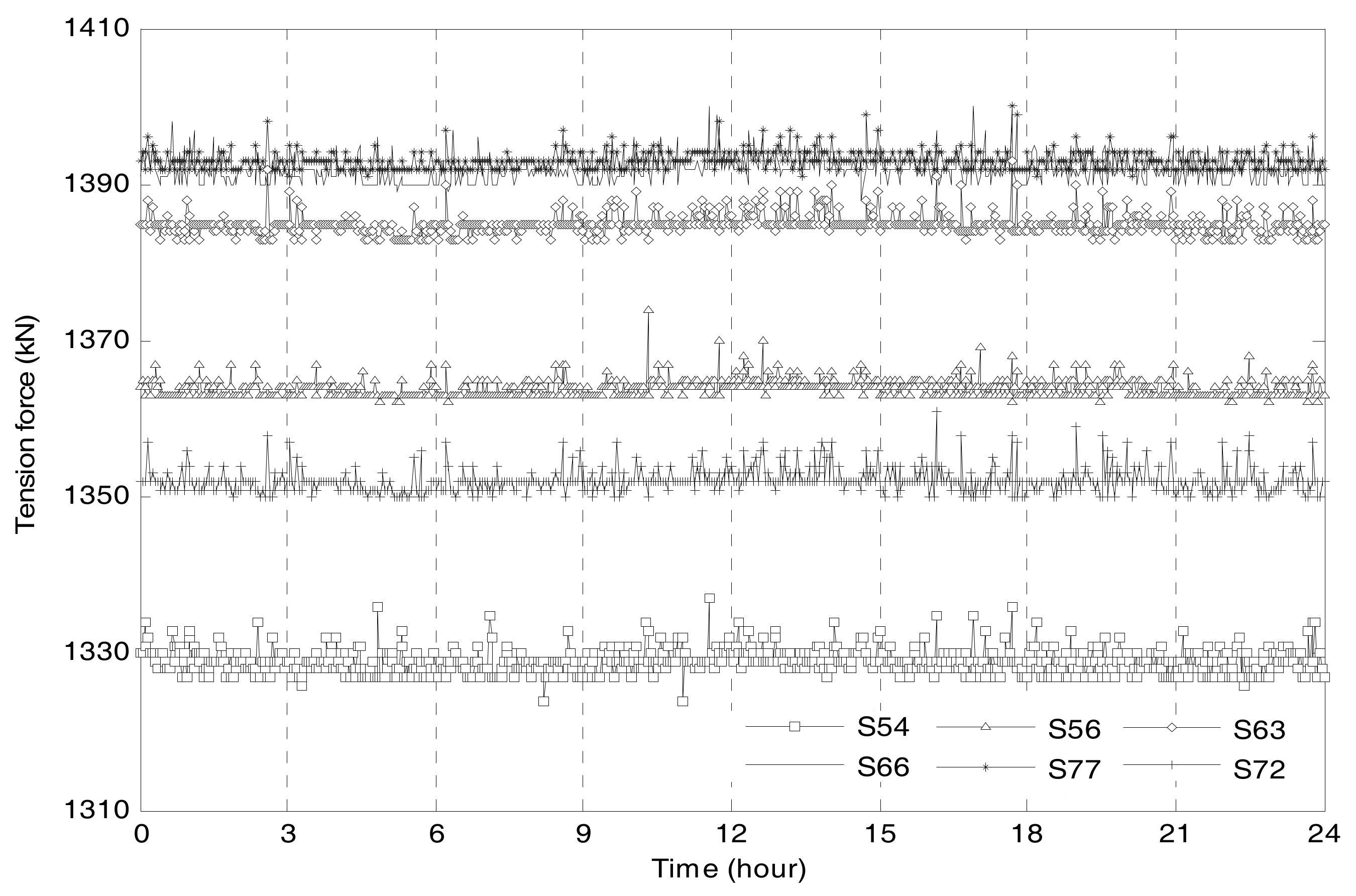

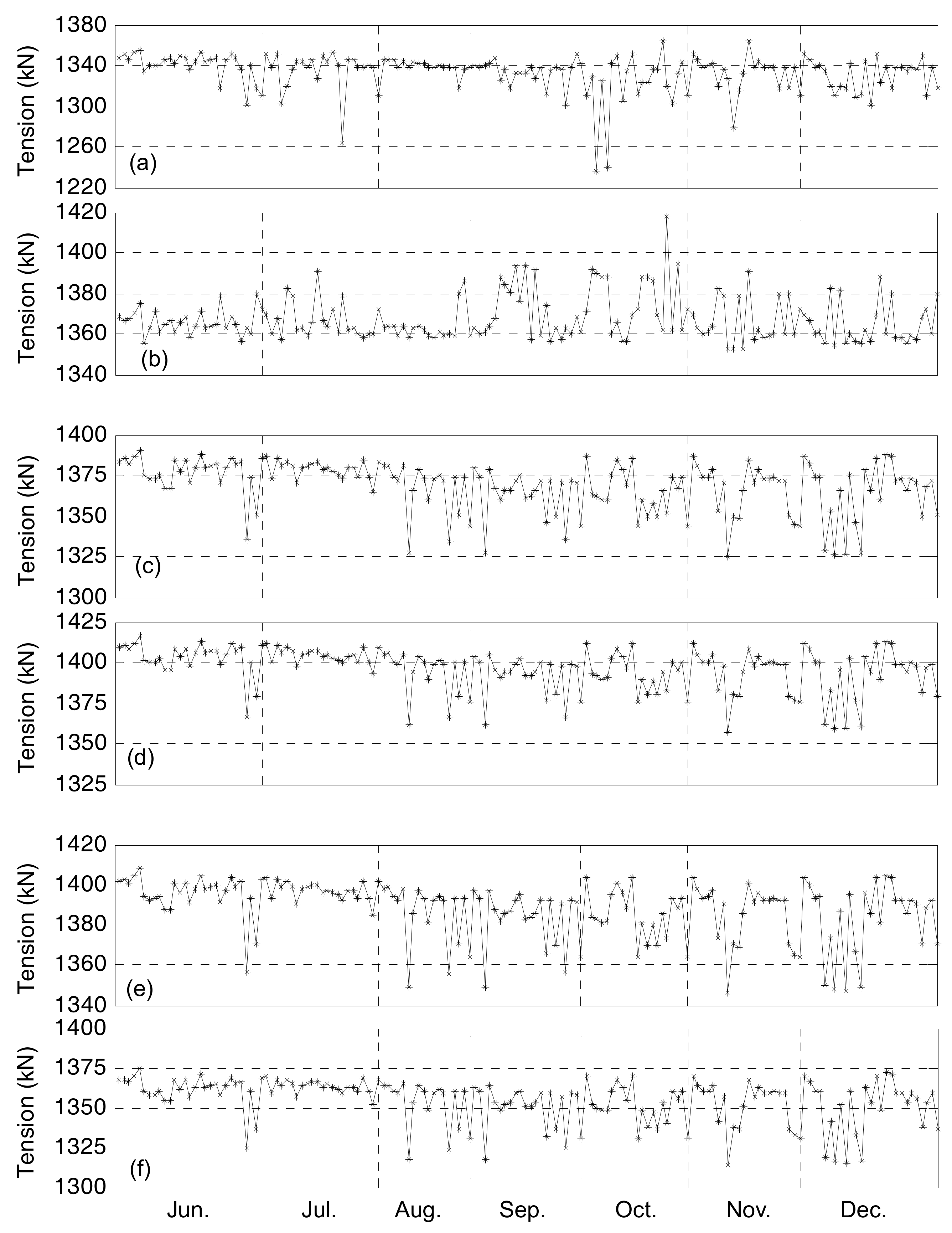
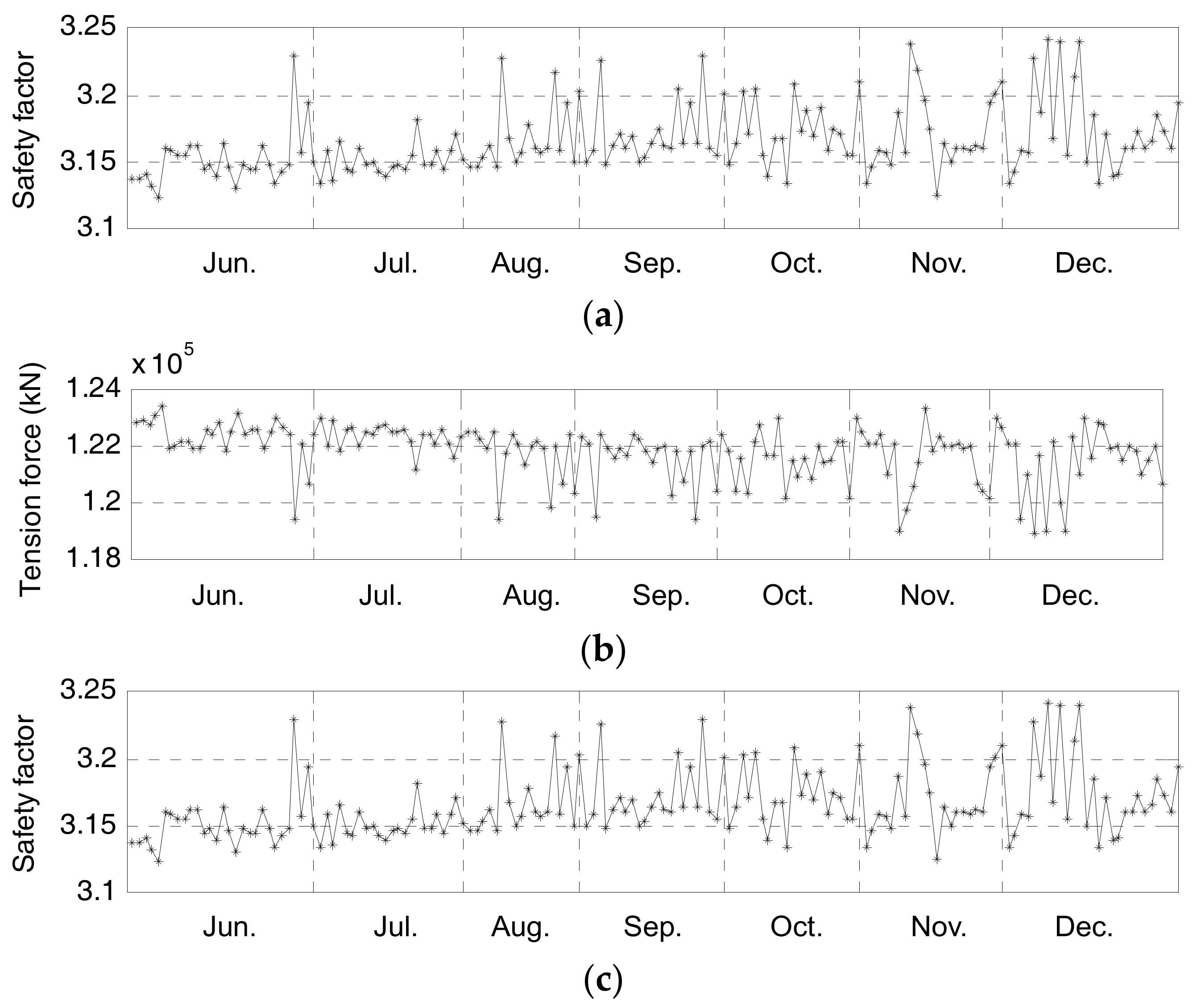
| Strand NO. | 54 | 66 | 56 | 77 | 63 | 72 | ||||||
|---|---|---|---|---|---|---|---|---|---|---|---|---|
| VST NO. | 1 | 2 | 3 | 4 | 5 | 6 | 7 | 8 | 9 | 10 | 11 | 12 |
| a | −12.7 | −42 | −9.1 | −15 | −7.3 | −9.7 | −6 | −9.8 | −6.13 | −12.3 | −8.6 | −12 |
| b | 1.595 | 1.591 | 1.569 | 1.538 | 1.584 | 1.540 | 1.548 | 1.536 | 1.552 | 1.553 | 1.552 | 1.587 |
| f1 | f2 | f3 | f4 | Baseline Temperature T0 | Initial Strain |
|---|---|---|---|---|---|
| 1989 Hz | 1988 Hz | 1990 Hz | 1991 Hz | 33 °C | 3329.0 με |
| Cable Strand | S54 | S66 | S56 | S77 | S63 | S72 |
|---|---|---|---|---|---|---|
| Min value (kN) | 1324 | 1388 | 1362 | 1391 | 1383 | 1349 |
| Max value (kN) | 1337 | 1400 | 1374 | 1400 | 1393 | 1361 |
| Mean value (kN) | 1329 | 1392 | 1364 | 1393 | 1385 | 1352 |
| Change range (kN) (Max − Min) | 13 | 12 | 12 | 9 | 10 | 12 |
| Cable Strand | S54 | S66 | S56 | S77 | S63 | S72 |
|---|---|---|---|---|---|---|
| Min value (kN) | 1236.7 | 1352.7 | 1324.8 | 1357.5 | 1346.4 | 1314.0 |
| Max value (kN) | 1364.6 | 1417.9 | 1390.4 | 1416.3 | 1407.8 | 1374.4 |
| Mean value (kN) | 1333.2 | 1367.5 | 1368.6 | 1396.2 | 1388.2 | 1354.5 |
| Change range (kN) (Max − Min) | 127.9 | 65.3 | 65.7 | 58.7 | 61.4 | 60.3 |
© 2017 by the authors. Licensee MDPI, Basel, Switzerland. This article is an open access article distributed under the terms and conditions of the Creative Commons Attribution (CC BY) license (http://creativecommons.org/licenses/by/4.0/).
Share and Cite
Deng, Y.; Liu, Y.; Chen, S. Long-Term In-Service Monitoring and Performance Assessment of the Main Cables of Long-Span Suspension Bridges. Sensors 2017, 17, 1414. https://doi.org/10.3390/s17061414
Deng Y, Liu Y, Chen S. Long-Term In-Service Monitoring and Performance Assessment of the Main Cables of Long-Span Suspension Bridges. Sensors. 2017; 17(6):1414. https://doi.org/10.3390/s17061414
Chicago/Turabian StyleDeng, Yang, Yang Liu, and Suren Chen. 2017. "Long-Term In-Service Monitoring and Performance Assessment of the Main Cables of Long-Span Suspension Bridges" Sensors 17, no. 6: 1414. https://doi.org/10.3390/s17061414
APA StyleDeng, Y., Liu, Y., & Chen, S. (2017). Long-Term In-Service Monitoring and Performance Assessment of the Main Cables of Long-Span Suspension Bridges. Sensors, 17(6), 1414. https://doi.org/10.3390/s17061414




